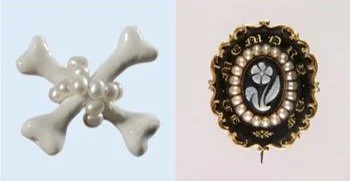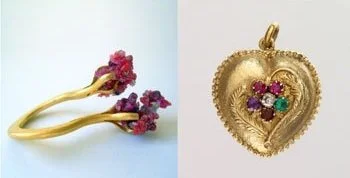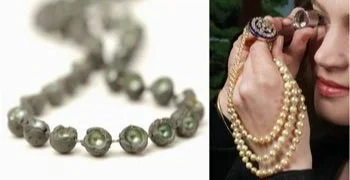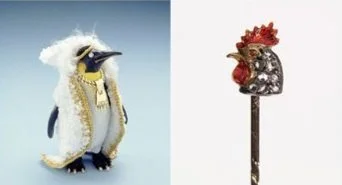Now & Then
17th July – 28th Sept 2008
Antique meets Contemporary
NOW & THEN
A remarkable exhibition of contemporary and antique jewellery exploring the timeless themes of power and politics, life and death, laughter and love.
The Lighter Side
Jewellery designed to make you smile! Felieke van der Leest combines her training as a gold and silversmith, her childhood love of crochet and needlework and her passion for animals (she grew up next to a zoo) to create her colourful, surreal jewellery. Little plastic animals are adorned with tiny crocheted clothes and their own jewels or embellishments – from Emperor Penguin Freddie adorned with a Polar Bear Claw pendant, to a lion cub with a gold saucepan hat and an extravagant gold ruff for a mane, or the mother polar bear having a baby! Felieke also makes quirky crocheted charm bracelets, which are shown alongside their antique equivalent, traditionally hung with charms to remind the owner of happy times or holidays.Lindsey Mann’s childhood was spent surrounded by her dad’s deconstructed collection of gadgets and mechanical or motorized ‘things’ – bits of which crept into the house and mingled with everyday belongings. This influence can be seen in her charming brooches and necklaces, which combine patterned aluminium, precious metals and found materials; some are ‘nonsensical mechanical inventions’, all of them, she hopes, trigger vague or familiar memories. For David Bielander, ‘wearers of jewellery move in the open, they are the exhibitions, they replace the wall, they are part of the work’. His ‘jewellery’ takes the shape of lips, a pearl pig, scampi polonaise or shiny black slugs – to be worn as and where the wearer chooses. Light, humorous, spontaneous – his aim through his work is to ‘provoke astonished reactions, make signals, create wonder, or simply make someone smile’.
Examples of antique jewellery based on animal forms show the lighter-hearted side of life in the past – with fun pieces such as a cockerel tie pin set with diamonds and enamel, circa 1890.
Now & Then runs from 17th July to 28th September 2008. Salts Mill is open weekdays from 10am – 5.30pm and weekends 10am – 6pm. For further information call 01274 599790.
Memento Mori
‘Bury Your X’ brooch by Claudia Stebler - ceramic, pearls,
with ‘Forget Me Not’ brooch - enamel, onyx, pearls C1850
Memento Mori
‘Not lost but gone before’ – our response to death and loss has long been expressed through jewellery, from the shapes and colours, to the motifs and materials. Traditionally worn to symbolise our own mortality, the mourning of a loved one or to record the passing of time, examples of Memento Mori jewellery include Georgian skull rings and sparkling Forget-Me-Not lockets and brooches. Taking their cues from such tradition, contemporary jewellers Constanze Schreiber and Claudia Stebler have created quirky representations not only of loss through death, but also through the ending of a relationship, divorce or leaving behind a place or a person - with the associated feelings of sadness, rage, relief – even joy! Using symbols such as skulls and skeletons, cross bones and coffins, they communicate this range of emotions through pieces such as Stebler’s ‘Bury Your X’ brooch and Schreiber’s ‘dead head’ brooch, delicate ‘in memoriam’ pendant and a chain of pearls to symbolize tears - black ones which are hollow and light, white ones which, on closer inspection, turn out to be tiny little skulls. A lock of hair has always symbolized romantic remembrance of a loved one, but it was the Victorians who made its use into a highly fashionable art form, either encasing hair in bejewelled rings and lockets or weaving or plaiting it into whole pieces such as earrings, pendants and crosses. Contemporary jeweller Melanie Bilenker uses up to 2,000 of her own hairs to create each one of the deceptively simple scenes depicted in her pendants – from reading a book to taking a bath – the minutiae of daily life is captured and treasured.
Sentiment & Sex
‘‘Two Claw Cluster’ ring by Kelvin Birk - 22ct gold, rubies and pink agate, with ‘REGARD’ gold heart pendant - Ruby, Emerald, Garnet, Amethyst, Ruby, Diamond c1840
Sentiment & Sex
Here we celebrate jewels with the power to seduce - or even to scandalize and look at the language of love, lust and longing – as expressed through jewels and stones. Jerwood prize-winning jeweller Adam Paxon creates bold acrylic jewellery which takes its influence from organic forms and nature’s colourful language of warning and courtship. His vibrant pieces, with names such as ‘Squirming' ring and ‘Spondylitis' neckpiece often attach to the body or clothing in unusual ways, giving new approaches to wearability - and a new meaning to ‘wearing your heart on your sleeve’!
By crushing and pulverizing precious gemstones such as sapphires, rubies and emeralds, then reforming them using molten gold or silver, Kelvin J Birk creates his intriguing rings in which the cooled, set metal holds or encloses the fragments of stones. Often working with second-hand or inherited pieces of jewellery, this process retains the sentiment of the original in the unique ‘freeform’ piece that emerges and expresses Kelvin’s belief that ‘nothing is constant, everything is transient … loss gives rise to new things … the constant circle of creation and destruction is unstoppable’. Now & Then’s examples of beautiful REGARD brooches and rings show how, by using a sequence of Ruby, Emerald, Garnet, Amethyst, Ruby and Diamond, the Victorians used stones in their own way to capture sentiments and messages. Similarly, floral bouquet brooches, often given as romantic gifts, were used by lovers to express sentiments such as love (rose), kiss (mistletoe), innocence (daisy). By beautiful contrast, the internationally renowned jeweller, Georg Dobler, shows his sumptuous brooches – silver and gold cast branches, foliage, flowers and fruit – rich and heavy with decadent stones.
Power & Politics
‘‘Dishonest Pearls’ necklace by Laura Deakin - wood filler, synthetic pearl lustre, silk thread and pigment with Susan Rumfitt examining a Victorian pearl necklace with enamel and diamond clasp c1860
Power & Politics
Pearls are probably the earliest natural object to have been prized as gems: the Ancient Egyptians were buried with theirs; to the Romans they were the ultimate symbol of wealth and status; brave Knights wore pearls to protect them in battle; and during the Renaissance laws decreed that only the nobility were allowed to wear them! Now & Then celebrates both the beauty and the power of pearls with examples of gorgeous antique brooches and necklaces, alongside Australian designer Laura Deakin’s ‘Dishonest Pearls’ - half circles made from wood filler into which a pearl is pushed, then removed, leaving the lustre lining the ‘shell shaped’ beads - a contemporary re-working of the familiar.In ancient times, cameos - literally, a stone carved in relief - were used to display faith or loyalty to a monarch; the Romans wore them as amulets or charms and ‘Renaissance men’ wore them as hat badges to emphasise their power and wealth. Given as gifts by Elizabeth I, collected by Catherine the Great and a favourite of the Empress Josephine, cameos were especially popular amongst the Victorians. In contrast to examples of fine Victorian pearls and cameos, both traditional symbols of materialism and status, Now & Then presents contemporary pieces such as the large, carved ‘Lingam’ pendant by well-known Dutch jeweller Ruudt Peters; an entwined collection of five ‘stylised penises’, this work reflects the spiritual beliefs of Eastern cultures in which the ‘Lingam’ is worshipped in order to bring good life – rather than having the Western associations with sex, power and pornography. Traditional medals awarded for ‘services to King and country’ are shown alongside Danish designer Inger Larsen’s ‘Medals for Everyday Heroes and Heroines’ - she takes the classical cross, crown or star shapes and creates outsize humorous versions in white acrylic and coloured ribbons - medals which can be pinned to your chest, bestowed upon your own hero, or hung on your wall! Exhibits by Susan Matsche (‘War Kills’) and Emily Bullock (‘Peace Piece’) are on loan from the powerful ‘Anti-War Medals’ international touring exhibition curated in 2005 by one of the USA’s most prestigious jewellery galleries, San Francisco’s Velvet da Vinci. Some 200 works by artists from 16 countries represented their protest against the War in Iraq. The British Museum and the Imperial War Museum have both purchased pieces from the exhibition.The use of jewellery as a sign of protest is explored with ‘Suffragette Jewellery’, set with jewels such as amethysts, peridots, tourmalines, emeralds and pearls, reflecting the Sufragette movements symbolic colours of green, white and violet (said by some to stand for Give Women the Vote). A modern-day campaigner, Silke Spitzer, shows her collection of bold brooches made using fair traded ‘ethical’ gold, linoleum and wood, focusing on issues of sustainability.
The Lighter Side
‘’Emperor Penguin Freddie with Polar Bear Claw Necklace’ by Felieke van der Leest - ring/object in plastic, textile, gold, cubic zirconia with ‘Cockerel’ tie pin in diamonds and enamel c1890
The Lighter Side
Jewellery designed to make you smile! Felieke van der Leest combines her training as a gold and silversmith, her childhood love of crochet and needlework and her passion for animals (she grew up next to a zoo) to create her colourful, surreal jewellery. Little plastic animals are adorned with tiny crocheted clothes and their own jewels or embellishments – from Emperor Penguin Freddie adorned with a Polar Bear Claw pendant, to a lion cub with a gold saucepan hat and an extravagant gold ruff for a mane, or the mother polar bear having a baby! Felieke also makes quirky crocheted charm bracelets, which are shown alongside their antique equivalent, traditionally hung with charms to remind the owner of happy times or holidays.Lindsey Mann’s childhood was spent surrounded by her dad’s deconstructed collection of gadgets and mechanical or motorized ‘things’ – bits of which crept into the house and mingled with everyday belongings. This influence can be seen in her charming brooches and necklaces, which combine patterned aluminium, precious metals and found materials; some are ‘nonsensical mechanical inventions’, all of them, she hopes, trigger vague or familiar memories. For David Bielander, ‘wearers of jewellery move in the open, they are the exhibitions, they replace the wall, they are part of the work’. His ‘jewellery’ takes the shape of lips, a pearl pig, scampi polonaise or shiny black slugs – to be worn as and where the wearer chooses. Light, humorous, spontaneous – his aim through his work is to ‘provoke astonished reactions, make signals, create wonder, or simply make someone smile’.
Examples of antique jewellery based on animal forms show the lighter-hearted side of life in the past – with fun pieces such as a cockerel tie pin set with diamonds and enamel, circa 1890.










